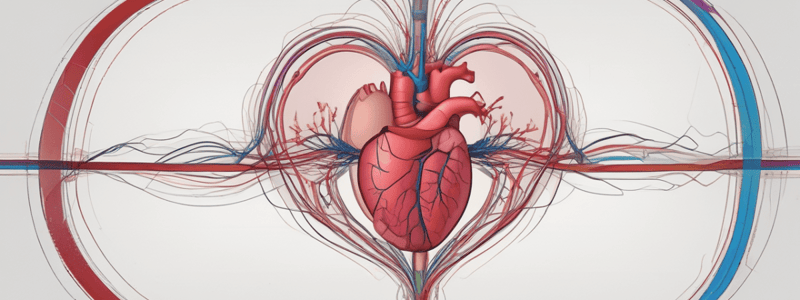Podcast
Questions and Answers
What is the pressure in the right atrium typically fluctuating around?
What is the pressure in the right atrium typically fluctuating around?
- 10 mmHg
- 15 mmHg
- 2 mmHg
- 5 mmHg (correct)
How does an increase in Right Atrial Pressure (RAP) affect venous return?
How does an increase in Right Atrial Pressure (RAP) affect venous return?
- Increases venous return
- Decreases venous return (correct)
- Disrupts the steady state relationship with cardiac output
- Has no effect on venous return
What determines venous return at steady state?
What determines venous return at steady state?
- Mean circulatory pressure (MCP)
- Right atrial pressure (RAP)
- Cardiac output (CO) (correct)
- Central venous pressure (CVP)
What does the vascular function curve show the relationship between?
What does the vascular function curve show the relationship between?
Which of the following shifts the match between cardiac output and venous return?
Which of the following shifts the match between cardiac output and venous return?
What does the mean systemic filling pressure (MSFP) represent?
What does the mean systemic filling pressure (MSFP) represent?
What is the theoretical pressure that would exist if the heart pump is turned off and blood is allowed to distribute throughout the vasculature until pressure is equal throughout?
What is the theoretical pressure that would exist if the heart pump is turned off and blood is allowed to distribute throughout the vasculature until pressure is equal throughout?
Which part of the cardiovascular system receives 64% of total blood volume in the systemic circulation?
Which part of the cardiovascular system receives 64% of total blood volume in the systemic circulation?
How do changes in blood volume and venous compliance affect the cardiac function curve?
How do changes in blood volume and venous compliance affect the cardiac function curve?
What does altering systemic vascular resistance (SVR) affect in the systemic function curves?
What does altering systemic vascular resistance (SVR) affect in the systemic function curves?
Which part of the cardiovascular system receives 7% of total blood volume in the systemic circulation?
Which part of the cardiovascular system receives 7% of total blood volume in the systemic circulation?
What is the structure responsible for receiving blood from the veins and pumping it to the right ventricle of the heart?
What is the structure responsible for receiving blood from the veins and pumping it to the right ventricle of the heart?
What is the main physiological effect of Natriuretic Peptides on blood vessels?
What is the main physiological effect of Natriuretic Peptides on blood vessels?
Which of the following is NOT a role of Natriuretic Peptides?
Which of the following is NOT a role of Natriuretic Peptides?
What is the main downstream effect of Natriuretic Peptides?
What is the main downstream effect of Natriuretic Peptides?
Which receptor type is primarily responsible for the main physiological effect of Natriuretic Peptides on blood vessels?
Which receptor type is primarily responsible for the main physiological effect of Natriuretic Peptides on blood vessels?
What are the main diagnostic markers associated with Natriuretic Peptides?
What are the main diagnostic markers associated with Natriuretic Peptides?
Which hormone is predominantly involved in promoting diuresis and natriuresis?
Which hormone is predominantly involved in promoting diuresis and natriuresis?
Flashcards are hidden until you start studying
Study Notes
Venous Return and Cardiac Output
- Venous return (VR) determines right atrial pressure (RAP)
- RAP determines VR
- At steady state, VR = cardiac output (CO)
Mean Systemic Filling Pressure (MSFP)
- Theoretical pressure if heart pump is turned off and blood is distributed throughout vasculature
- Changes with changes in venous compliance or capacitance, and blood volume
Right Atrial Pressure (RAP)
- Typically low, fluctuating around a mean of 0 mmHg
- Required for pressure gradient to drive venous return (VR)
- Difference between central venous pressure (CVP) and RAP is the driving pressure for blood into the atrium (ΔP = CVP-RAP)
Vascular Function Curve
- Shows the relationship between venous return and right atrial pressure
- Changes in blood volume and venous compliance cause parallel shifts in the curve
- Changes in systemic vascular resistance (SVR) alter the slope of the curve without changing MSFP
Cardiac Function Curve
- Shows the relationship between cardiac output and right atrial pressure
- At steady state, venous return = cardiac output
Natriuretic Peptides
- Downstream effect: promote smooth muscle cell relaxation, diuresis, and natriuresis
- Counter regulatory hormones and useful diagnostic markers
- Main physiological effect comes from the NP receptor type A, the predominant receptor on blood vessels
Studying That Suits You
Use AI to generate personalized quizzes and flashcards to suit your learning preferences.



